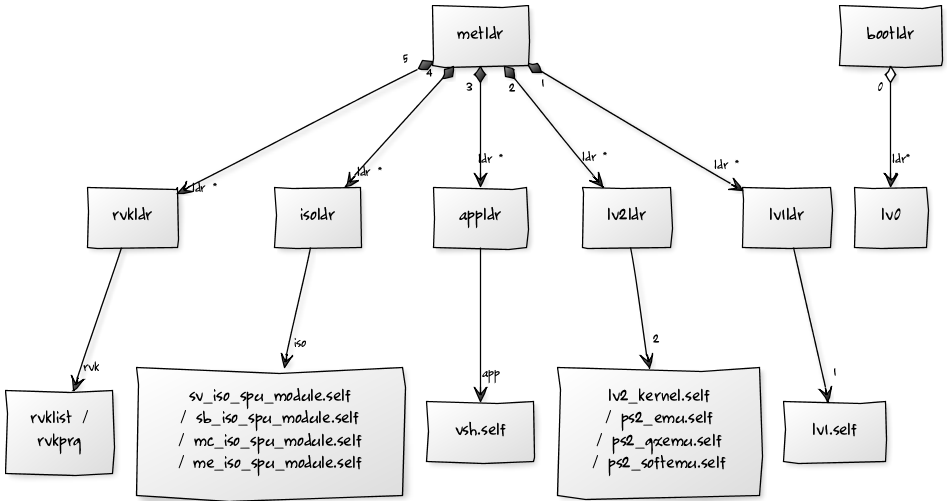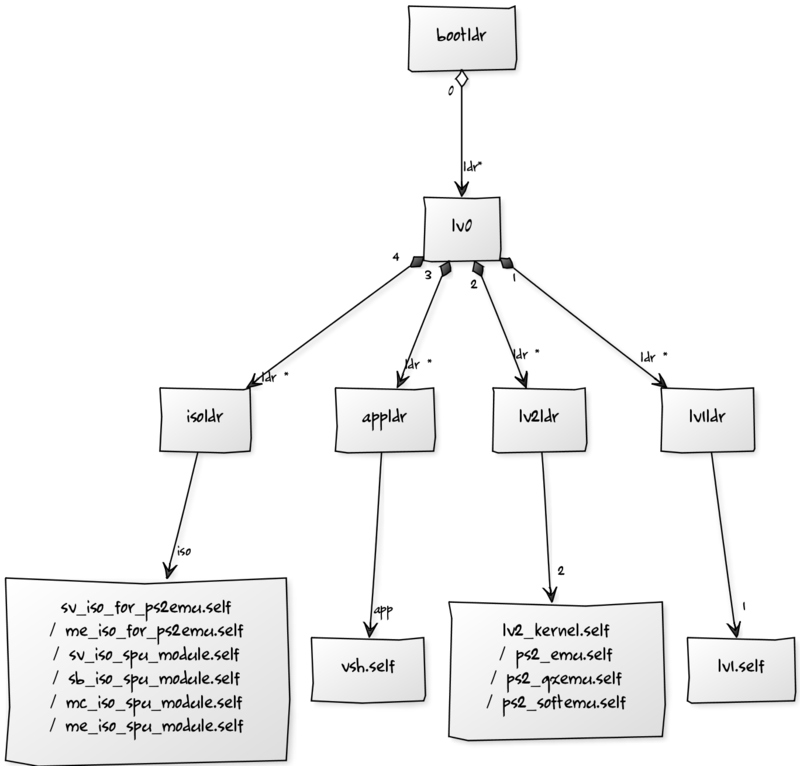Boot Order: Difference between revisions
m (→References) |
m (→References) |
||
| Line 27: | Line 27: | ||
=== References === | === References === | ||
* [http://ip.com/patapp/US20090055637 Secure power-on reset engine] // http://ip.com/pdf/patent/US7895426.pdf | * [http://ip.com/patapp/US20090055637 Secure power-on reset engine] // http://ip.com/pdf/patent/US7895426.pdf | ||
* [http://www.multiupload.com/7STWIQ8PBF CellBEBootprocess.pdf (177.69 KB)]) / | * [http://www.multiupload.com/7STWIQ8PBF CellBEBootprocess.pdf (177.69 KB)]) // | ||
* [http://www.multiupload.com/KZPVRP2JP8 CBE_Secure_SDK_Guide_v3.0.pdf (182.63 KB)]) // | * [http://www.multiupload.com/KZPVRP2JP8 CBE_Secure_SDK_Guide_v3.0.pdf (182.63 KB)]) // | ||
* [http://www.multiupload.com/9L0M97K4CH CellBE_HIG_65nm_v1.01_8Jun2007.pdf (2.38 MB)]) // http://www.ps3devwiki.com/files/documents/-%20Cell%20BE/CellBE_HIG_65nm_v1.01_8Jun2007.pdf | * [http://www.multiupload.com/9L0M97K4CH CellBE_HIG_65nm_v1.01_8Jun2007.pdf (2.38 MB)]) // http://www.ps3devwiki.com/files/documents/-%20Cell%20BE/CellBE_HIG_65nm_v1.01_8Jun2007.pdf | ||
Revision as of 19:08, 14 February 2012
Boot Sequence
Power on : syscon boots from it's internal (non-encrypted / dual banked) ROM *1 *2
+ syscon powers up various power subsystems + syscon powers up cell and checks status + syscon sends Cell configuration ring to Cell + syscon pulls the reset of Cell high -> Cell INIT
Cell INIT: CELL boots from it's internal ROM *2
+ Initialises I/O + fetches encrypted bootldr off NAND (at address 0x000000) /NOR flash (at address 0xFC0000) + Initialises RAM + loads bootldr into Isolated SPU (SPE0) + Runtime Secure Boot decrypts and verifies bootldr and executes + bootldr decrypts lv0 which runs on PPU -> loaders INIT
loaders INIT: lv0 loads metldr (SPE2)
+ passes lv1ldr (which loads lv1) to metldr + passes lv2ldr (which loads lv2) to metldr + passes appldr (which loads vsh) to metldr + passes isoldr (which loads *.iso_spu_module) to metldr + passes rvkldr (which loads rvkprg / rvklist) to metldr
- 1) Read/Writeable with undocumented / should also be read/writeable through serial port and possible to switch it to the backup bank1 with backup_mode pulled high
- 2) CEX/Retail consoles go to standby with red light. SEX/SHOP/SECH will not standby, but instead boot through without waiting for powerbutton. Also check is done on all models if update is flagged to set it into firmware updating procedure
- 3) Partialy Read/Writeable
about the disabled SPE: syscon reads it’s internal (non-encrypted) eeprom @ 0x48C30 which is value 0×06 on all CEX/Retail consoles and will set the cell config ring accordingly for 7 SPE’s. SPE0 and SPE2 are reserved for bootldr and metldr for isolation respectively. Setting the value to a nonworking state (e.g. 0×00, 0xFF, enabling a defective SPE or disabling a needed SPE for proper boot) might brick the console, locking you out from restoring the correct value to the syscon eeprom.
References
- Secure power-on reset engine // http://ip.com/pdf/patent/US7895426.pdf
- CellBEBootprocess.pdf (177.69 KB)) //
- CBE_Secure_SDK_Guide_v3.0.pdf (182.63 KB)) //
- CellBE_HIG_65nm_v1.01_8Jun2007.pdf (2.38 MB)) // http://www.ps3devwiki.com/files/documents/-%20Cell%20BE/CellBE_HIG_65nm_v1.01_8Jun2007.pdf
- CellBE_HIG_90nm_v1.5_30Nov2007_pub.pdf (2.38 MB)) // http://www.ps3devwiki.com/files/documents/-%20Cell%20BE/CellBE_HIG_90nm_v1.5_30Nov2007_pub.pdf
Chain of Trust
| Name | Location | Processor | Encryption | Updateable | Revokable | Usage | Exploited |
|---|---|---|---|---|---|---|---|
| Runtime Secure Boot | Hardware based | Cell | Hardware Based | no | no | Verification of images loaded into isolated SPE | no |
| bootldr (Boot Loader) | NAND (0x000000) / NOR (0xFC0000) | SPE(0) | Per Console Encrypted at factory | No * | No | Setup Primairy Hardware + load lv0 | No |
| lv0 (Level 0) | NAND/NOR (COREOS) | PPU | Static Encryption / Signed | Yes | No | Setup Hardware | No |
| metldr (asecure_loader) | NAND (0x0040810) / NOR (0x000810) | SPE(2) | Per Console Encrypted at factory | No * | No | load loaders (Meta Loader) | Yes |
| lv1ldr (Level 1 (Hypervisor) Loader) | NAND/NOR (COREOS) | SPE(2) | Static Encryption / Signed | Yes | No | Decrypt lv1 (Hypervisor) | Yes |
| lv2ldr (Level 2 (GameOS) Loader) | NAND/NOR (COREOS) | SPE(2) | Static Encryption / Signed | Yes | No | Decrypt lv2 (GameOS) | Yes |
| appldr (Application Loader) | NAND/NOR (COREOS) | SPE(2) | Static Encryption / Signed | Yes | Yes | Decrypt games | Yes |
| isoldr (Isolation Loader) | NAND/NOR (COREOS) | SPE(2) | Static Encryption / Signed | Yes | No | Decrypt modules | Yes |
| rvkldr (Revokation Loader) (Discarded after 0.8) | NAND/NOR (COREOS) | SPE(2) | Static Encryption / Signed | Yes | No | Decrypt revoke list | Yes |
* : ofcourse with new hardware revisions, it is updated in factory. See Flash#new_metldr.2
Chain of trust Diagram
Runtime Secure
This runtime secure boot, in fact, is tightly coupled with an SPE entering isolation mode. An application must go through the hardware authentication step before it can execute on an isolated SPE. When isolation mode is requested, first, the previous thread is stopped and cancelled. Then, the hardware will automatically start fetching the application into the LS, and the hardware will verify the integrity of the application. If the integrity check fails, the application will not be executed. The check can fail for one of two reasons. The application might have been modified within memory or storage. Then, the assumption is that the functionality might have changed and it cannot be trusted anymore. Or, the writer of the application does not know the cryptographic secret that is needed for a successful authentication. Otherwise, if the authentication check is successful, the hardware will automatically kick-start the application's execution in isolation mode. Because the hardware controls all of these steps, the verification of the application's integrity cannot be skipped or manipulated and will happen consistently and correctly.
Changes in firmware 3.60
Lv0 has now been changed, LV0 now appears to encapsulate all of the Loaders (appldr, isoldr, lv1ldr, lv2ldr). Now in order to break the chain of trust we need to be able to decrypt/exploit LV0 (or bootldr which loads LV0).

